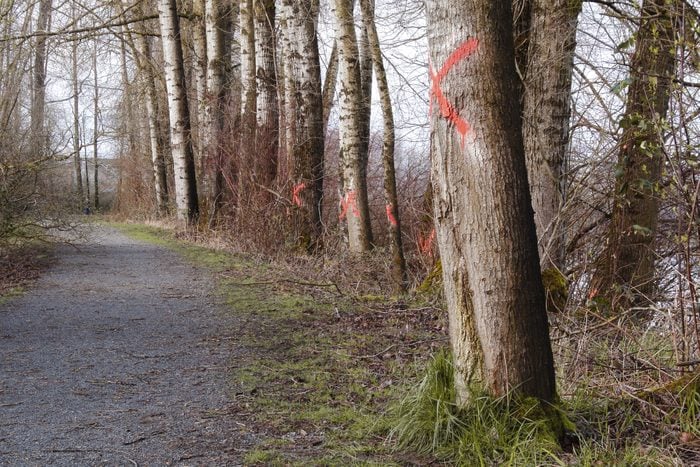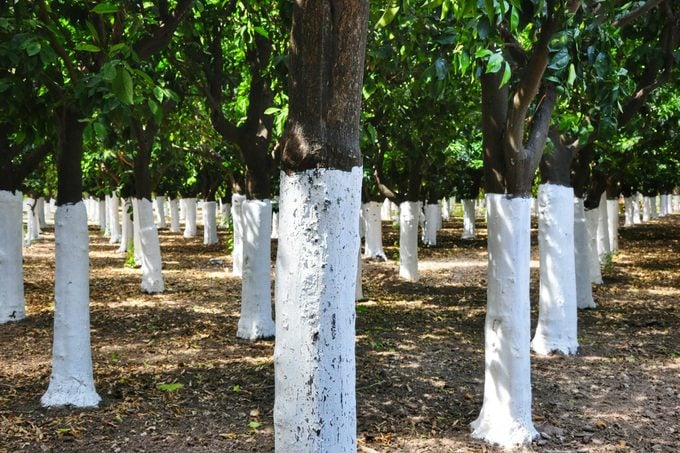If You See Paint on Trees, This Is What It Means
Updated: Apr. 09, 2024

Seeing blue dots, red Xs, orange circles and purple bands on trees and wondering what they mean? Here's what we found out about those painted trees.
Whether you’re walking along a city sidewalk or hiking deep in the forest, you might occasionally notice paint marks on tree trunks. Those marks are codes used by forestry workers and contractors to pass along a range of messages, from which trees to chop down to which ones need treatment for disease.
On This Page
Why Are Trees in the City Marked With Paint?
All cities have codes for marking trees. Here we’ll use Boulder, Colorado, as an example. In Boulder, when you see a dot at the base of the tree, that signifies it needs treatment for emerald ash borer, elm scale or drippy blight. Paint dots at head height mean the tree needs pruning.
“Basically, it marks the tree in an inconspicuous way,” says Ken Fisher, assistant forester for the Boulder Parks and Recreation Department. “A lot of people don’t even notice it, but it alerts our contractor that this is the tree we’re talking about. We’ve been using paint dots for 25 years or so now, so some trees have several paint dots on them.”
Pruning and treatment dots also give a heads-up to property owners near the trees. This way, when the city notifies them of an upcoming pruning or treatment, they know which trees will be affected.
Why Are Trees in the Forest Marked with Paint?
Paint in the forest often has something to do with a timber sale. Circles, Xs, and dots in various colors identify which trees are to be cut, which ones are hazards and which ones should be left alone. They also mark property boundaries and environmental concerns.
“In some places, trees with nests of rare or endangered species are marked,” says Christopher Evans, extension forestry and research specialist at the University of Illinois Urbana-Champaign. “That is the case with the federally endangered red-cockaded woodpecker in the Southern United States. Their tree nests are generally marked with a white paint ring.”
In Western states, a paint ring may signify a tree affected by mountain pine beetles. A splotch of head-high color could also be a trail marker, showing hikers or mountain bikers which way to go.
Are Painted Tree Markings Universal in the Forest?
Not really. “Basically, there aren’t any hard and fast standardizations for the use of marking paint in forestry,” Evans says. “That can lead to confusion when trying to generalize the meaning of different symbols and colors.”
But there are a few generalities with forestry markings, he says. An X often marks a hazard or tree to be removed. Circles and dots can mean trees to take, but sometimes they mean trees to leave. Numbers on trees are usually to tally them before a harvest. In many states, purple paint is a universal sign of a property boundary, which means no trespassing.
The U.S. Forest Service (USFS) has a few standards. According to Donna Nemeth, USFS regional press officer, in most cases red paint designates the boundary of USFS land. Orange or yellow paints are used for harvest boundaries, and trees within those areas have blue, orange, green or yellow paint, depending on whether they are to be taken or spared. A black paint mark is an “eraser,” correcting a mistake.
Are Painted Tree Markings Universal in the City?
Again, nope. But back to the Boulder example. There, they switch up marking colors every year.
“There’s only really like half a dozen colors that stand out on the tree, bright colors like blue, red, yellow and orange,” says Fisher. “We’ve reused those colors over and over. This year’s pruning events are red, and I’ve gone to trees that have a red paint dot from this year and also one from years ago.”
Why are Trees Painted White?

When the entire lower trunk of a tree is painted white, it’s usually to prevent sunscald. Sunscald happens in winter when bark cracks and splits due to temperature fluctuations between cold nights and direct sunlight. It not only damages the tree, but can make it susceptible to pests and pathogens.
“This type of painting is typically done on thin-barked residential trees or orchards,” says Evans. “Painting the trunks white is said to moderate the daytime heating of the bark and lessen the chances of sunscald injury.”
What is the Paint Marking for Emerald Ash Borer Treatment?
It varies from town to town. In Boulder, they use three colors of dots near the base of a tree to show it’s being treated for emerald ash borer. That’s because, Fisher says, “we’re on a three-year rotation with treatments. We do one-third of our treated trees each year, which is just over 1,000 per year.”
Is Paint on Trees Used to Deter Pests?
Sometimes, but it’s not a great idea. “Some people do paint wounds or cut surfaces, such as after pruning, as a way of deterring pests,” says Evans. “But it is generally not recommended as the paint over the wound impedes the tree’s ability to seal over the wound and it traps moisture which can enhance rot.”
What if I Want to Know More About Specific Painted Tree Markings in My Town?
Your town forestry department can help, and may even have more detailed information on their website. In Boulder, they have a tree mapping link where you can zoom in on your property and see an aerial image of all of the nearby public trees and their species.
